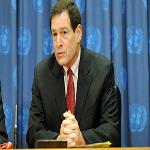30 November 2010

Photo: ? UNICEF/NYHQ2008 -1235/Markisz
Chief of UNICEF's HIV/AIDS Program Division, Jimmy Kolker (file photo)
A new study by the United Nations Children's Fund says discrimination and stigmatization limit women and children getting access to HIV prevention, treatment and social protection. UNICEF is calling on the international community to step up efforts to provide universal access to lifesaving programs.
The report says substantial progress is being made in the prevention of mother-to-child transmission of HIV. The chief of UNICEF's HIV/AIDS Program Division, Jimmy Kolker, says mother-to-child transmission of the deadly disease could be virtually eliminated by 2015.
"This is not something that is beyond the technology or the infrastructure of even difficult places like DRC [Democratic Republic of Congo]," Kolker said. "I think the characterization that some countries are doing poorly is probably unfair. There is measurable progress in every country, including certainly Nigeria. Their coverage is better, their quality of services is better, the number of facilities offering pediatric care and mother and child transmission enrollment is growing."
Although many children are benefiting from these treatment programs, UNICEF says there are millions of women and children who are falling through the cracks.
It blames this on a number of wide-ranging inequities rooted in gender, economic and social status, geographical location and education. The report says it is crucial to lift these barriers, so all women and children can get the care and treatment they need to prevent HIV.
The World Health Organization reports nearly 1,000 babies in sub-Saharan Africa are infected with HIV through mother to child transmission, every day.
WHO has issued new guidelines for treating infants and children with anti-retroviral therapy. The guidelines are meant to pave the way for many more children with HIV to be eligible for immediate treatment.
But, Kolker says studies show that pediatric treatments continue to lag behind.
"Even where early infant diagnosis is available and is offered to many thousands of children, the cascade, the number who do not end up, if the test is positive, getting on medication, which would be life saving, a remarkable impact on young children," Kolker added. "But, the majority of kids in the countries we studied did not actually access the medication, even though the test results did show they were positive."
UNICEF says the number of children under age 15 receiving anti-retroviral treatment in low and middle-income countries is growing. However, it is far from sufficient. It says only 28 percent of the 1.27 million children estimated to be in need of the treatment receive it.
The latest AIDS report shows in most parts of the world, new HIV infections are steadily falling or stabilizing. But, UNICEF notes adolescents are still becoming infected with HIV because they have neither the knowledge nor the access to services to protect themselves.
The UNICEF report says it is possible to attain an AIDS-free generation. But, that means erasing the inequities that fuel the epidemic and protecting those who continue to fall through the cracks.